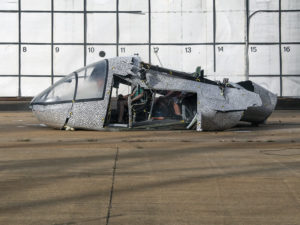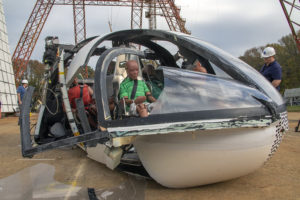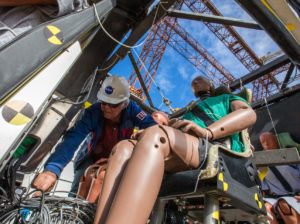NASA researchers recently completed a full-scale crash test of an electric vertical takeoff and landing (eVTOL) concept vehicle at the Landing and Impact Research (LandIR) facility at NASA’s Langley Research Center in Hampton, Virginia.
The eVTOL was a ‘Lift+Cruise’ test article developed by the Revolutionary Vertical Left Technology (RVLT) project in another effort for NASA to advance research for the Advanced Air Mobility (AAM) mission.
‘)
}
// –>
NASA’s vision for AAM is to help emerging aviation markets safely develop an air transportation system that moves people and cargo between places previously not served or underserved by aviation.
Understanding how these future aircraft may act in a crash scenario is another key point of research.
Hoisted into the air, then released with pyrotechnic cutters, the model swung forward and down back to the Earth with a loud crash.

The RVLT Lift+Cruise Model rests on the ground after suffering a devastating crash. Tests like these enable researchers to understand how a vehicle’s structure reacts to a crash. Credits: Dave Bowman
“The test was a great success for the crash-worthiness team at Langley,” said Justin Littell, research assistant for Langley’s Structural Dynamics Branch. “We successfully tested the eVTOL vehicle concept representing a six-passenger, high wing, overhead mass, multiple rotor vehicle, obtaining more than 200 channels of data, and collecting over 20 onboard and off-board camera views.”
A variety of experiments were included on the test article. These experiments included several seat configurations including a NASA energy absorbing concept, various sizes of crash test dummies to study the effects of the crash loads on all sizes of occupants, and a modular NASA-developed energy-absorbing composite subfloor.
“While we are still going through the data and video, and these results are preliminary, we see that there are two main events that occurred during this test,” said Littell.
The first event was the floor crushing and seat stroking. The subfloor and energy absorbing seats functioned as intended and limited the effect of the impact on the crash test dummies.
The second was the collapse of the overhead structure. The effect of the overhead structure collapse on the crash test dummies is still being determined.
For this test, an overhead-mass was designed to represent the wing structure, rotor and battery. The decision was made to assume that all the weight of the overhead structure was over the cabin. There are many other overhead-mass configurations which may behave differently in a crash.

Crash test dummies can be seen seated in the vehicle after suffering a severe crash. The vehicle was destroyed beyond expectations which gives researchers valuable data when planning to make AAM vehicles safe for public use. Credits: Dave Bowman
“When looking at crash conditions for these types of vehicles, it’s important to note the structural weight and distribution that must be made when examining a specific design,” said Littell.
The test data will be used to refine modeling techniques and reported to the AAM community so that it can be discussed.
“Our computational pretest models did a good job predicting the composite deformation until overhead structural failure,” said Littell. “However, the computational models did not predict the overall collapse as seen in the test.”
The full-scale testing data will be used to improve the simulation models such that in the future, the predictions will be more realistic. The data will further be used as the basis for evaluating potential test conditions and configurations that will be used during a drop test of a second Lift+Cruise test article, scheduled for testing in late 2023.

A NASA researcher assists in the preparation of a crash test dummy seated inside the Lift+Cruise model. Researchers use crash test dummies to learn how the crash impact would affect humans. Credits: Dave Bowman






